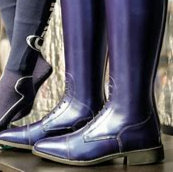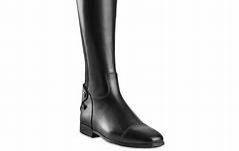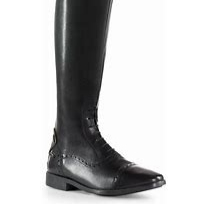Do female riders really pick fashion over function?!
- pegasusphysiotherapy
- May 10
- 4 min read
Updated: Jun 7
Recently, I shared a post on social media about the design of modern riding boots after a male commenter suggested that women choose fashion over function - and claimed there are plenty of properly fitting boots if people "looked hard enough."
❌ But in my Rider Physio sessions, I see this issue impacting rider biomechanics again and again. Too many riders unintentionally ride on their toes - not because they don’t know better, but because their boots are working against their feet. That’s why I keep repeating:
👉 We need to assess foot position - not just boot position - in the stirrup.
Why? 🤔
✅ Many boots are too narrow, pushing the ball of the foot further back than the rider realises.✅ Coaches often cue foot placement based on how the boot looks in the stirrup - not how the rider’s foot is functioning.✅ It’s even become fashionable to ride on the toe to achieve an exaggerated 'heels down' look - which stiffens the ankle, over-stretches the foot, and reduces mobility.
The response to my post was overwhelming. Female riders are NOT choosing fashion over function - they simply don’t have functional options.
The number of people struggling to find boots that fit properly is staggering. And that’s just among riders who are already aware of the issue. I suspect many more have unknowingly adapted their riding to poor boot fit - blaming themselves instead of the gear.
A Quick History of Women’s Riding Boots 👢🕰️
1700s–1800s
Women’s riding boots were nearly identical to men’s: sturdy, flat-heeled, functional.
Both sidesaddle and astride riders used practical boots.
Fashion boots were worn OFF the horse, not in the saddle.
Late 1800s to 1920s
Factory-made riding boots appeared for men first; women’s versions followed.
Early factory boots were still strong and well-fitted.
An example of vintage boots (care of google- so no exact times for these styles but were all for women)
Post–World War II
Horses became a leisure/sport activity, not transport.
Fashion ideals shifted to elegance & femininity.
Boots became narrower, sleeker, and image-driven.
1950s Onward
The "small waist, elegant silhouette" trend influenced breeches, jackets - and boots.
Narrow, polished designs were marketed - not designed for real riding function.
Women didn’t ask for uncomfortable gear - the industry simply stopped offering anything else.
Today: Mass Production & Poor Fit 🏭❌
Since the 1990s, mass-produced riding boots have exploded in availability - but not in variety.
Narrow molds based on outdated sizing standards are still used.
Modern research shows women’s feet are now wider, longer, and structurally different than 50-100 years ago - yet boot designs haven’t kept up.
Many riders size UP to fit boots, which alters their balance & stirrup position.
The result?
👉 Performance suffers.
👉 Rider confidence takes a hit.
👉 Safety is compromised.
👉 And no one is talking about it.
Many riders have to size up to make boots wearable, which alters stirrup position and balance.
Why Boot Fit Matters for Rider Biomechanics ⚙️🐎
Poor boot fit affects far more than comfort:
✅ Riders are taught to place the ball of the foot on the stirrup.
✅ But narrow or pointed boots often shift the ball of the foot further back.
✅ Many instructors cue from the boot seam - which is often where the toes bend, not where the ball of the foot is.
✅ This forces riders into unsafe, unstable positions - and leads to confusion or unfair criticism about “incorrect” foot placement.
✅ The ball of foot gives riders balance and that's what we want as riders!
🦶 Try This at Home: The Boot Fit Test
Want to see exactly what your boots are doing to your feet?
👉 Place your bare foot on a piece of paper and trace around it.
👉 Now place your boot on top and trace its outline.
👉 Compare the two.
❓ Does your foot fit comfortably within your boot outline?
If not - where is the rest of your foot going inside the boot?
Answer: it’s being compressed.
Compression problems:
❌ Toes get squashed inward.
❌ The metatarsals lose their natural spread.
❌ Balance, foot control & proprioception are compromised.
❌ Over time: bunions, neuroma, chronic inflammation can develop.
❌ Worst of all - feel & responsiveness are reduced - the opposite of what riders need.
👉 Read more here about where the ball of your foot really is - and why it’s so vital for balance!
It’s Not Just Boots - It’s Clothing Too! 👖👕
Post-war fashion ideals also shaped riding clothing:
Breeches got tighter.
Show jackets became more tailored.
Riders were expected to look elegant - even if it compromised function.
Modern sportswear has improved, but much of what’s sold as “biomechanics clothing” still offers the bare minimum - a few stripes or lines here and there.
SymmFit: Designed for Performance You Can See 👀✅
That’s why I created SymmFit - a rider clothing range designed by a rider physio, focused on function first, without sacrificing style.
SymmFit tops & jodhpurs feature:
✅ Technical fabrics - breathable, flexible, high-performance.
✅ Advanced visual guidance: vertical, horizontal & angled lines for posture, symmetry & balance.
✅ Support for riders, coaches & physios to give more accurate feedback.
✅ Help riders match feel with correction - to ride better, not just look better.
👉 Check out the new SymmFit Website
What’s Next: The Rider Boot Fit Survey 📝
I’m preparing to launch a large-scale rider survey on foot & boot fit.
Why? Because riders care about this issue. We want to feel:
✅ Confident.
✅ Balanced.
✅ Supported.
We deserve gear that works with our bodies - not against them.
Until then, I’ll keep posting about real rider alignment - from the ball of the foot to the shoulder–hip–heel line - and challenging the outdated idea that function comes second to fashion.
Because the truth is simple:
👉 Riders haven’t stopped caring about function.
👉 The industry just stopped offering it.
✨ Sign up to receive the Pegasus Newsletter and be part of the community working to become better, more balanced riders! Join us here.
.png)















